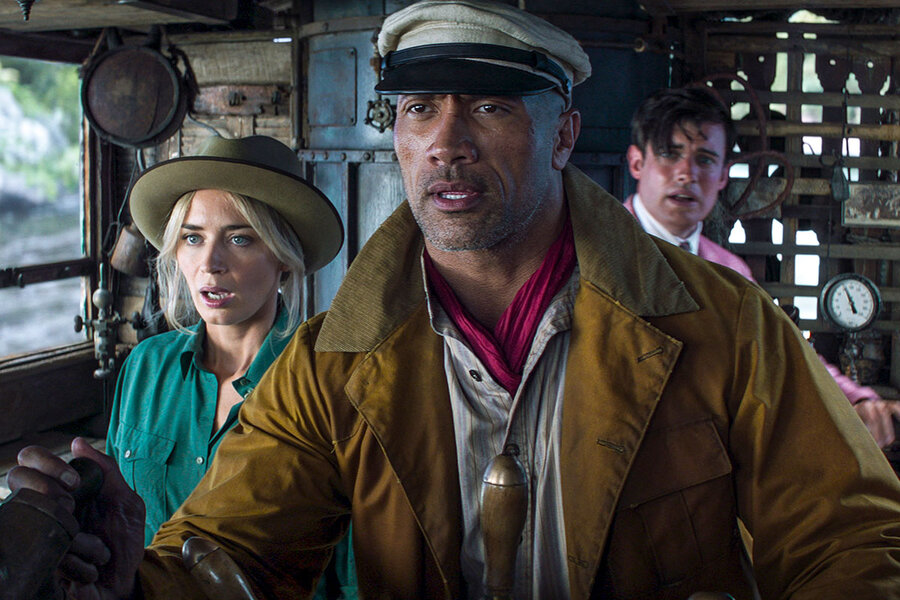Grab your oar: ‘Jungle Cruise’ takes viewers on a wild ride
Loading...
“Jungle Cruise,” opening July 30, is just the latest of many movies Disney has based on its theme park rides – from “Pirates of the Caribbean” to “Country Bears” to “The Haunted Mansion” to “Tomorrowland.” What’s left? If viewers end up having as much fun as the “Jungle Cruise” actors do on screen, would Disney move on to “it’s a small world”? Perish the thought.
Emily Blunt plays Lily Houghton – essentially a female Indiana Jones – who ventures to the Brazilian jungle in 1916. Dwayne Johnson (aka The Rock) plays Frank Wolff, the skipper of a small steamboat who ferries her up the Amazon. Lily’s patrician brother MacGregor (Jack Whitehall) also tags along for the ride. Their quest: find a mythical and mystical flower called Tears of the Moon. The trio is pursued by a German military commander, Prince Joachim (Jesse Plemons), who believes that the flower’s healing powers will help his nation win the Great War. Additional dangers lie in store, from perilous waterfalls to a tribe of alleged man-eaters in the jungle.
The movie version of “Jungle Cruise” adapts some of its story points from the original theme park ride (though some aspects, such as the depiction of the tribe as primitive cannibals, have been revised – in keeping with recent updating to the attraction). Yet the movie mostly steals the best parts of other movies, including “The Mummy” and “Pirates of the Caribbean.”
Why We Wrote This
If a movie is based on a theme park ride, does it follow that it’s not good? Chief culture writer Stephen Humphries says that spirited “Jungle Cruise” is fueled by energetic acting that helps it to rise above its commercial origins.
To compensate for the lack of originality, the screenwriters have assembled familiar ingredients. For instance, Lily and Frank bring a humorous twist to the rope swing sequence lifted from the “Romancing the Stone” poster. During an action scene reminiscent of “Raiders of the Lost Ark,” James Newton Howard’s score for “Jungle Cruise” pays homage to John Williams’ soundtrack from that earlier movie. Johnson as Frank even models the very same cap that Humphrey Bogart wore in “The African Queen.”
Like Katharine Hepburn in the aforementioned movie, Lily wears a pair of trousers. Bemused at her unconventional clothing, Frank takes to calling her Pants. Her retort is to nickname him Skippy. The wonderful comedic chemistry between the duo keeps the movie floating well above the waterline when it gets bogged down with CGI-heavy action. Johnson is in his wheelhouse in more ways than one – with the boat captain leaning on his natural charm, even when he’s selfish and duplicitous.
Following a string of mostly serious roles, Blunt lets her hair down, just like her character does. (Kudos to her for the rare feat of not looking completely ridiculous in a pith helmet.) “Jungle Cruise” is the first movie in quite some time to fully tap into her vivacious star power. The two leads aren’t the only ones having a blast. Plemons is a hoot as a pompous villain who isn’t averse to breaking into song with his crew of henchmen. Paul Giamatti shows up with a dubious Italian accent and a parrot on his shoulder.
The production’s level of craftsmanship is high. Yet director Jaume Collet-Serra never does anything that’s artistically risky. (The closest the movie gets to a left-field choice is roping in Metallica to perform an orchestral-rock version of their song “Nothing Else Matters” during an intense action scene.) Everything is carefully calibrated to be on-brand for Disney. So a scene in which someone comes out as gay seems like an effort to redress criticism about the corporation’s lack of (openly) LGBTQ characters. The sensitively played revelation is accepted with grace rather than judgment. But it’s not particularly believable for the time period.
Similarly, the modern-day take on colonialism, Indigenous people, and gender roles can feel as if it wandered in from another era and sticks out, like, well, a hippopotamus on the riverbanks of the Amazon. Which is to say that “Jungle Cruise” was never authentic in the first place. That goes for the location filming, which took place in Georgia and Hawaii rather than South America. The jungle’s creatures and landscape shots are all pixel dust. We’re not expecting believability.
The one thing that isn’t artificial – the most important element of all – is the movie’s spirit. Acting in franchise blockbusters often amounts to get-the-job-done professionalism. In “Jungle Cruise,” however, the actors approach the material as if they’re enjoying a day out at Disneyland. At one point, Blunt grabs hold of a rope and pauses to beam with unfeigned glee. Then the actor gets hoisted up, but she’s already soaring.
“Jungle Cruise” is in theaters and available to stream for an additional fee starting July 30 on Disney+. The film is rated PG-13 for sequences of adventure violence.






